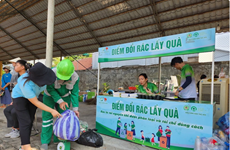Thanh Hoa strives to be more disaster resilient this rainy season
Natural disasters have taken a heavy toll on the north-central province of Thanh Hoa over recent years. To be more resilient to the disasters this year, the province has been repairing and upgrading dykes and other irrigation systems as the rainy season is just around the corner.
 Illustrative image. (Photo: VNA)
Illustrative image. (Photo: VNA)Thanh Hoa (VNA) – Natural disasters have taken a heavy toll on the north-central province of Thanh Hoa over recent years. To be more resilient to the disasters this year, the province has been repairing and upgrading dykes and other irrigation systems as the rainy season is just around the corner.
In March, the provincial Department of Agriculture and Rural Development issued an official dispatch to direct the People's Committees of districts and companies that manage irrigation works to inspect them before the start of the rainy season.
The department has directed localities to develop disaster and emergency response plans for reservoirs. It also told localities to run trial of pumping stations, drains and flood discharge systems of reservoirs to ensure they are functioning properly.
In the mountainous district of Quan Hoa, the local People’s Committee has adopted a plan on natural disaster control and rescue for this rainy season with a focus on flash flood and land slide control, prevention of flood at and in lower plains surrounding reservoirs, and evacuation of people living in flood-prone areas.
The district has made efforts to promptly repair and upgrade dykes and reservoirs and mobilized personnel to dredge canals and clean up waterways so as to prevent flood. It has developed different scenarios to deal with reservoir emergencies in towns and communes in the lower plains of hydroelectric reservoirs, such as Trung Thanh, Thanh Son, Phu Thanh, Phu Xuan, and Hoi Xuan. At the same time, it has raised awareness among the local people of siren sound that will warn them of the sudden water flow discharge from hydropower plants in their areas.
Head of the district’s agriculture department Do Phi Hung said Quan Hoa has provided training for local people to increase their awareness of how to respond to the disasters. It has implemented the plan to control flash flood and landslide in each hamlet and village, as well as installed warning signs at risky areas, he noted.
Flood-prone communes have formed surveillance teams as well as search and rescue, and medical teams assigned with specific tasks during the rainy season. Additionally, the communes must deploy local people to keep a 24/7 watch of reservoirs to promptly cope with any emergency and ease damage and losses caused by floods.
Authorities in Thieu Hoa district have also formulated plans on natural disaster prevention and search and rescue missions, and worked around the clock to speed up the progress of dyke projects. The district has stockpiled 7,300 packages, 145 life jackets, 400 sqm of canvas of different types, and 1,700 bamboo poles to get prepared against floods.
It has cooperated with relevant agencies to remove difficulties and fast-track the project that repairs a section of dykes on the right bank of Chu River, which was behind the schedule.
Thieu Hoa has viewed disaster control and prevention, and search and rescue mission as two among the district’s most important tasks, said Vice Chairman of the district’s People Committee Nguyen The Anh. Similar to Quan Hoa, Thieu Hoa has also set up surveillance teams to keep a close watch on dykes and fix those sustaining damage from the flood season last year.
To gear up for the rainy season, the provincial Department of Dyke Management and Flood, Storm Control has plans in hand to evacuate the locals living along rivers and streams prone to flash flood and landslide, and to ensure sufficient personnel and materials for disaster control.
Thanh Hoa has over 1,000 km of dykes, 610 reservoirs, 1,023 spillways, 885 pumping stations and 14 large drains that take daily wastewater to rivers.
The provincial Department of Agriculture and Rural Development has warned that 131 reservoirs in 16 districts and towns do not meet safety standards as the rainy season has arrived. The rainy season runs from July to October.
Of the unsafe reservoirs, 124 were reported unsafe in 2018 and seven others during this year’s pre-flood inspections.
Most spillways in the province have small capacities and an average height of about 5 metres. Many were not constructed solidly enough to withstand heavy rain or flooding, and were easily damaged or washed away.
Thirty-six spillways in six districts were partly damaged during the 2018 flood season. Fourteen were in Lang Chanh District, 13 in Ngoc Lac, five in Quan Hoa, three in Nhu Xuan and one in Nhu Thanh.
Mostly built in the 1980s, pumping stations (including drainage and irrigation stations) were designed with low capacities and now have outdated machinery and equipment. These stations have not been upgraded due to a lack of funding, resulting in poor performance, reduced capacity and high energy consumption. -VNA












